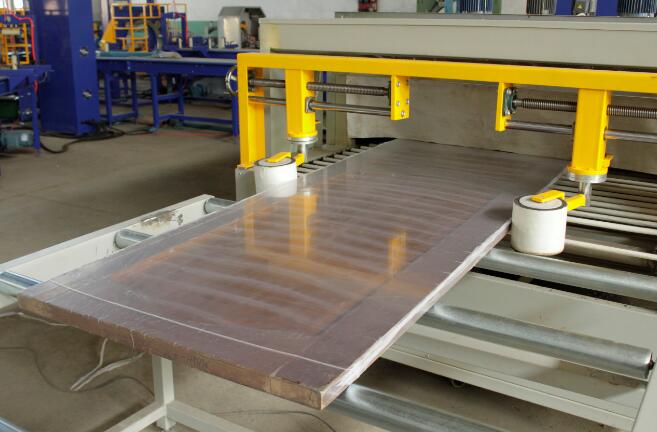Optimizing Door Packaging: How Automated Shrink Wrapping Reduces Labor Costs
In the demanding world of manufacturing, particularly for large items like doors, optimizing packaging processes is crucial for maintaining competitiveness. Manual packaging methods can be labor-intensive, slow, and prone to inconsistencies. Implementing an automated full-size sealed door packing shrinking machine presents a robust solution to enhance efficiency, improve package quality, and significantly cut down on labor expenditures. This guide explores the operational advantages and key considerations of adopting this technology.

Understanding Automated Door Shrink Wrapping Systems
A full-size sealed door packing shrinking machine is an industrial system specifically designed to automate the process of applying and heat-shrinking polymer film around large, flat items such as wooden, metal, or composite doors. The process typically involves:
- Infeed: Doors are conveyed into the machine.
- Film Application: A layer of shrink film is precisely dispensed and sealed around the door.
- Heat Tunnel: The wrapped door passes through a heat tunnel where controlled temperatures cause the film to shrink tightly, conforming to the door's shape.
- Cooling & Outfeed: The finished package is cooled to set the film and then discharged.
This automation replaces manual measuring, cutting, sealing, and shrinking, tasks that traditionally require multiple operators.
The Impact of Automation on Packaging Labor Costs
Integrating automated shrink wrapping directly addresses labor costs in several key ways:
1. Minimizing Manual Handling and Operator Requirements
The most direct benefit is the reduction in personnel needed on the packaging line. A single automated system can often perform the work of several manual laborers, freeing up staff for other value-added tasks. This translates to lower direct labor costs, reduced recruitment and training overhead, and less strain on human resources.
2. Increasing Packaging Throughput and Speed
Automated systems operate at consistent, high speeds, far exceeding manual capabilities. This increased throughput allows manufacturers to meet higher production demands, reduce lead times, and handle peak periods without needing to scale up the workforce proportionally. Faster cycle times mean more products shipped per shift, directly improving operational efficiency.
3. Enhancing Consistency and Reducing Errors
Manual wrapping can lead to variations in wrap tightness, seal integrity, and overall appearance. Automation ensures uniformity and precision in every package, reducing material waste from poorly wrapped items and minimizing the risk of product damage during transit due to inadequate protection. This consistency also enhances brand presentation.
Key Features and Capabilities of Modern Door Shrink Wrappers
Advanced door shrink wrapping machines incorporate features designed for optimal performance, reliability, and ease of use:
- Precise Film Control: Systems accurately manage film tension, sealing parameters, and cutting for minimal waste and a secure wrap.
- Advanced Temperature Regulation: Sophisticated heat tunnels provide uniform heat distribution and precise temperature control, critical for achieving a perfect shrink without damaging the door surface or film. Different film types (e.g., polyethylene, polyolefin) may require specific temperature profiles.
- Integrated Conveying Systems: Smooth and synchronized conveyors ensure seamless product flow into, through, and out of the machine, preventing jams and maintaining operational rhythm.
- User-Friendly HMI (Human-Machine Interface): Intuitive touchscreen interfaces allow operators to easily set parameters, select pre-programmed recipes for different door sizes or types, monitor operations, and troubleshoot issues quickly.

door packing machine fhope Operational Advantages Beyond Labor Savings
While labor cost reduction is significant, the benefits extend further:
- Improved Safety: Automated systems enclose moving parts and heating elements, reducing the risk of burns, cuts, or repetitive strain injuries associated with manual wrapping. Features like emergency stops and safety interlocks are standard. ([External Link Idea: Link to OSHA machine guarding standards])
- Reduced Material Consumption: Precise film dispensing and consistent shrinking minimize the amount of film needed per package compared to manual methods, lowering material costs.
- Space Efficiency: While the machine itself has a footprint, automating the process can consolidate the packaging area, potentially freeing up valuable floor space compared to multiple manual wrapping stations.
- Data Logging and Diagnostics: Many modern machines offer real-time monitoring and data logging capabilities, aiding in performance tracking, predictive maintenance, and identifying areas for process optimization.
Considerations for Implementation
Selecting and integrating a full-size door shrink wrapper requires careful planning:
- Product Range: Assess the dimensions (height, width, thickness) and weight variations of the doors to be packaged to ensure the chosen machine has the necessary capacity and flexibility.
- Required Throughput: Match the machine's speed capabilities to your production volume requirements.
- Film Compatibility: Verify the machine can handle the type and gauge of shrink film best suited for your product protection needs and budget.
- Integration: Plan how the machine will fit into your existing production line, including infeed and outfeed connections.
- Maintenance: Understand the machine's maintenance requirements and ensure access to technical support and spare parts. ([Internal Link Idea: Link to a maintenance best practices article on your site])
- ROI Calculation: Factor in the initial investment, installation costs, expected labor savings, material cost reductions, and potential increases in throughput to calculate the return on investment.

door film shrinking machine Conclusion: Investing in Packaging Efficiency
For manufacturers dealing with large products like doors, transitioning from manual packaging to a full-size sealed door packing shrinking machine offers a compelling pathway to significant labor cost reduction and enhanced operational efficiency. These automated systems deliver speed, consistency, and improved safety, contributing directly to a leaner, more competitive manufacturing operation. By carefully evaluating machine capabilities against production needs, businesses can make a strategic investment that yields long-term benefits in cost savings, product quality, and overall productivity.

